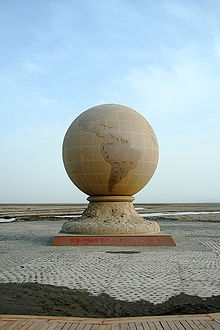| Aydingkol | |
|---|---|
 Stele at Aydingkol Stele at Aydingkol | |
 | |
| Location | Turfan Depression, Xinjiang Uyghur Autonomous Region |
| Coordinates | 42°39′27″N 89°16′14″E / 42.65750°N 89.27056°E / 42.65750; 89.27056 |
| Etymology | Moon Lake in Uyghur |
| Basin countries | China |
| Surface elevation | −154 m (−505 ft) |

Aydingkol (Uyghur: ئايدىڭكۆل, Айдиңкөл, Aydingköl), Aydingkul (Mongol) or Ayding (Chinese: 艾丁湖; pinyin: Àidīng Hú) is a lake in the Turpan Depression, Xinjiang Uyghur Autonomous Region, PR China. At 154 m below sea level, it is the lowest point in China. This lake is now totally dried, and very muddy and salty.
History
In ancient times, Ayding Lake was known as juéluòwǎn (觉洛浣). The Uyghur derived name Aydingköl means "moon lake", due to the lake having a layer of white salt along its edge, giving the appearance of a shining moon.
Geography
The lake is located in the south hinterland of the Turpan Depression, approximately 35 kilometres away from the city of Turpan. From east to west, the lake spans 40 kilometres; the north-south span is 8 kilometres; and the total area of the lake is 200 square kilometres. The lake was formed from the formation of an orogeny of the Himalayas 249 million years ago, and once held approximately 5 million square kilometres of inland sea, which at one time surged up and became vastly extended. During the winter of 1948, the lake basin was once filled with freshwater, which primarily originated from melted snow water from the mountains, as well as supplementary groundwater; owing to the lesser use of water to irrigate cultivated land during the winter, the water level was higher. During the summertime, the water level declined as a result of increased use of irrigation water for farming, as well as significant natural evaporation. Due to the expansion of farming in the region, the population using water from the lake subsequently increased, and by 1958 the lake only held up to 22 square kilometres, with a water depth of about 0.8 metres. As of 2000, except for the southwest region, little lakewater remained, and the entire lake area has become a saltpan, with the centre of the lake holding silt swamps, and no longer holds any native birds. During times of intense sunshine, mirages can often be seen.
Nowadays, Ayding Lake has a salt mill, which uses the region's alum salt crystals and saltpeter raw materials to manufacture chemical products. Scenic tours also run near the lake.
On 24 July 2015, a new China-wide high temperature record was set at a meteorological station near Aydingkol, with a temperature of 50.3 °C (122.5 °F), a record it held until 17 July 2023 when Sanbao hit 52.2 °C (126 °F).
See also
References
- Mackerras, Colin; Yorke, Amanda (1991). The Cambridge handbook of contemporary China. Cambridge University Press. p. 192. ISBN 0-521-38755-8. Retrieved 2008-06-04.
+Aydingkol.
- Murray, Geoffrey; Cook, Ian G. (2002). Green China: Seeking Ecological Alternatives. Routledge. p. 4. ISBN 0-7007-1703-X. Retrieved 2008-06-04.
- "50.3°C吐鲁番市艾丁湖刷新"中国热极"记录". 天山网. Archived from the original on 23 September 2015. Retrieved 29 July 2015.
- "China logs 52.2 Celsius as extreme weather rewrites records". Reuters. 17 July 2023. Retrieved 22 October 2024.
This Xinjiang location article is a stub. You can help Misplaced Pages by expanding it. |